Related Research Articles
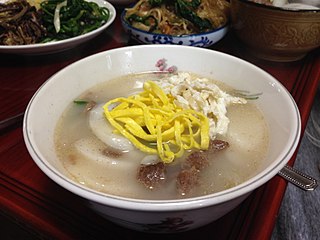
Tteokguk (떡국) or sliced rice cake soup is a traditional Korean dish eaten during the celebration of the Korean New Year. The dish consists of the broth/soup (guk) with thinly sliced rice cakes (tteok). It is tradition to eat tteokguk on New Year's Day because it is believed to grant the people good luck for the year and gain a year of age. It is usually garnished with thin julienned cooked eggs, marinated meat, gim (김), and sesame oil (참기름).

Nian gao, sometimes translated as year cake or New Year cake or Chinese New Year's cake, is a food prepared from glutinous rice flour and consumed in Chinese cuisine. It is also simply known as "rice cake". While it can be eaten all year round, traditionally it is most popular during the Chinese New Year. It is considered good luck to eat nian gao during this time of the year because nian gao (年糕) is a homonym for "higher year" or "grow every year" (年高), which means "a more prosperous year". The character 年 is literally translated as "year", and the character 糕 (gāo) is literally translated as "cake" and is identical in sound to the character 高, meaning "tall" or "high". In Mandarin, Nian gao (年糕) also is an exact homonym of "sticky cake" (黏糕/粘糕), the character 黏/粘 (nián) meaning "sticky".

Tteok is a class of Korean rice cakes made with steamed flour made of various grains, including glutinous or non-glutinous rice. Steamed flour can also be pounded, shaped, or pan-fried to make tteok. In some cases, tteok is pounded from cooked grains.

A rice cake may be any kind of food item made from rice that has been shaped, condensed, or otherwise combined into a single object. A wide variety of rice cakes exist in many different cultures in which rice is eaten. Common variations include cakes made with rice flour, those made from ground rice, and those made from whole grains of rice compressed together or combined with some other binding substance.

Rice flour is a form of flour made from finely milled rice. It is distinct from rice starch, which is usually produced by steeping rice in lye. Rice flour is a common substitute for wheat flour. It is also used as a thickening agent in recipes that are refrigerated or frozen since it inhibits liquid separation.
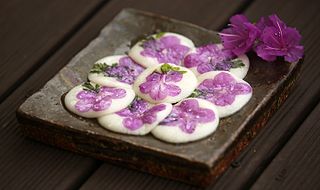
Hwajeon, or flower cake is a small Korean pan-fried rice cake. It is made out of glutinous rice flour, honey and edible petals from seasonal flowers, such as rhododendron. It is eaten during the festivals of Samjinnal and Buddha's Birthday.
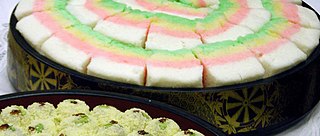
Mujigae-tteok (Korean: 무지개떡) or rainbow rice cake is a layered tteok of different colors resembling a rainbow. It is used for special occasions such as a banquet, party, or feast like doljanchi, hwangapjanchi. Alternative names for mujigae-tteok include saektteok (색떡) and saekpyeon (색편), both of which means "colored rice cakes".
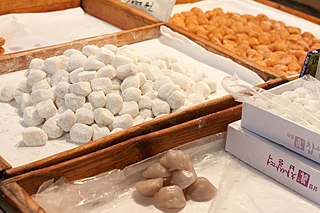
Chapssal-tteok, also called chaltteok, is a tteok, or Korean rice cake, made of glutinous rice.
Gaepi-tteok (개피떡) or baram-tteok (바람떡) is a half-moon-shaped tteok made with glutinous rice flour and filled with white adzuki bean paste.
Korean regional cuisines are characterized by local specialties and distinctive styles within Korean cuisine. The divisions reflected historical boundaries of the provinces where these food and culinary traditions were preserved until modern times.

Gyeongdan (경단) or Korean rice ball cake is a type of tteok made of glutinous rice or other glutinous cereal flours. When the cereal other than rice is used, its name is usually specified, making compound nouns such as susugyeongdan. The name chapssalgyeongdan may also be used, but chapssal can be, and usually is, omitted.
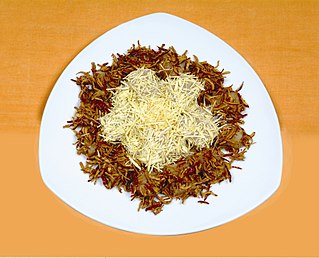
Danja is a variety of steamed tteok made with glutinous rice flour, sweet fillings, and sweet coatings.

Jeolpyeon (절편) is a type of tteok made of non-glutinous rice flour. Unlike when making siru-tteok or baekseolgi, the rice flour steamed in siru is pounded into a dough, divided into small pieces, and patterned with a tteoksal. The stamps can be wooden, ceramic, or bangjja (bronze), with various patterns including flowers, letters, or a cartwheel. When served, sesame oil is brushed over jeolpyeon.

Bukkumi (Korean: 부꾸미) is a pan-fried tteok made with glutinous rice flour or sorghum flour. It is a flat half-moon shaped cake filled with white adzuki bean paste or mixture of toasted and ground sesame seeds, cinnamon powder, and sugar or honey. The color varies from white to yellow, pink, or dark green. Bukkumi is often coated with honey or syrup, and garnished with shredded chestnuts, jujube, or rock tripe. There is also a variety of bukkumi which is flat and round and does not have any filling.
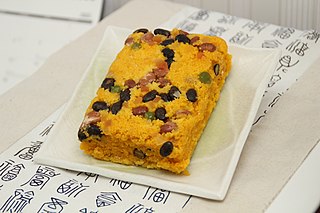
Hobak-tteok (호박떡) is a variety of siru-tteok made by mixing fresh or dried pumpkin with glutinous or non-glutinous rice flour, then steaming the mixture in a siru.
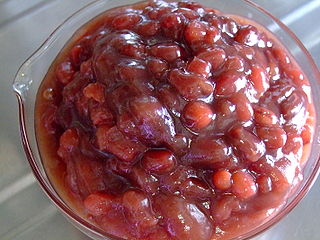
Red bean paste or red bean jam, also called adzuki bean paste or anko, is a paste made of red beans, used in East Asian cuisine. The paste is prepared by boiling the beans, then mashing or grinding them. At this stage, the paste can be sweetened or left as it is. The color of the paste is usually dark red, which comes from the husk of the beans. In Korean cuisine, the adzuki beans can also be husked prior to cooking, resulting in a white paste. It is also possible to remove the husk by sieving after cooking, but before sweetening, resulting in a red paste that is smoother and more homogeneous.
References
- 1 2 김, 재호. "chanochi" 차노치. Encyclopedia of Korean Local Culture (in Korean). Academy of Korean Studies . Retrieved 20 May 2017.
- ↑ "cha-" 차-. Standard Korean Language Dictionary (in Korean). National Institute of Korean Language . Retrieved 20 May 2017.
- ↑ "noti" 노티. Standard Korean Language Dictionary (in Korean). National Institute of Korean Language . Retrieved 20 May 2017.
- 1 2 "chanochi" 차노치. Doopedia (in Korean). Doosan Corporation . Retrieved 20 May 2017.